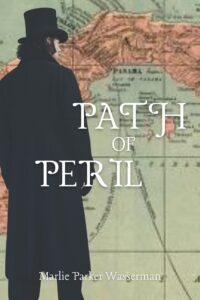 Of the many questions my readers and other writers ask me, my favorite is why I gravitate to historical fiction rather than contemporary topics. My questioners seem awed by the amount of research I undertake. They don’t know my secret. For me, writing historical fiction is easier than writing about this year or last year. The historical record gives me an outline, a frame, a beginning. To write, I simply fill in the blank spaces.
Of the many questions my readers and other writers ask me, my favorite is why I gravitate to historical fiction rather than contemporary topics. My questioners seem awed by the amount of research I undertake. They don’t know my secret. For me, writing historical fiction is easier than writing about this year or last year. The historical record gives me an outline, a frame, a beginning. To write, I simply fill in the blank spaces.
To explain this, I should add that I don’t focus on famous people. Yes, my latest novel, Path of Peril, is inspired by President Theodore Roosevelt’s 1906 trip to Panama, to observe progress on the canal, but TR remains in the background. I focus instead on two other categories of lesser-known people.
My plot centers on the minor officials and journalists who traveled with Teddy Roosevelt. The best example is a thirty-seven-year-old man named Maurice Latta. He served as TR’s assistant secretary. In 1906, this title meant more responsibility than we might expect. As the only staffer to accompany TR to Panama, Mr. Latta acted as the advance man and the scheduler. What we know about him could fill a thimble. But that thimble gave me the start I needed to fill in the picture. I learned that before going to the White House, Latta worked in a claims office during the Oklahoma land rush, leading me to guess he witnessed land stolen from Native Americans and might show more understanding than others about the Barbadian laborers who dug the canal. I learned that Latta had never traveled outside the U.S., leading me to guess he experience anxiety about a trip to Panama. I learned that Latta never went to college, leading me to guess he might feel intimidated by the better educated office workers in the White House. The spare facts I uncovered gave me the skeleton of a character, a skeleton I fleshed out with my many guesses.
While embellishing details about little-known characters, I also created completely unknown characters. The servants working for the engineers who designed the canal and the laborers who dug the canal left almost no written records. Half a dozen of these men and women drove my plot. To envision them, I read three books by historians about the history of Barbados, where most of the laborers came from. I found enough background information to help me depict characters who sought higher wages while encountering abusive conditions on their path to a better life. In addition, I portrayed two groups of fictional anarchists who want to assassinate Theodore Roosevelt. To get this right, I read books and articles on anarchism during the late nineteenth and early twentieth centuries. Using those accounts, I envisioned anarchists who travel to Panama with TR. Historians gave me a frame that I filled in.
Other writers prefer to begin with a blank slate, where they can create anyone, doing anything, anywhere. I prefer to begin with a frame of historical facts, then fill in that frame with an imagined picture. The frame itself sparks my imagination.
Would the assassins plotting to kill Theodore Roosevelt on his visit to the Panama Canal succeed? Until this trip, no president while in office had ever traveled abroad. White House secretary Maurice Latta, thrilled to accompany the President, could never have anticipated the adventures and dangers ahead. Latta befriends watchful secret service agents, ambitious journalists, and anxious First Lady Edith Roosevelt on their hot and humid trip, where he observes a country teeming with inequalities and abounding in opportunities. Along the way he learns about his own strengths—what he never imagined he could do, and what he discovers he can’t do.
Theodore Roosevelt did visit Panama in 1906, accompanied by White House staffer Maurice Latta. Path of Peril imagines what the newspapers feared to report and what historians never discovered about Roosevelt’s risky trip.
Buy Links:
Social Media:
Facebook Marlie Wasserman
Instagram marliepwasserman
X @MarlieWasserman


Ooh, Susan and blog guest Marlie Parker Wasserman… this book sounds so good that I just ordered it! Thanks for showing us how research sparks your stories and how you use it to flesh out the bones, as you say, Marlie. I’m a not-yet-published-but-trying historical mystery writer, and appreciate the inspiration.